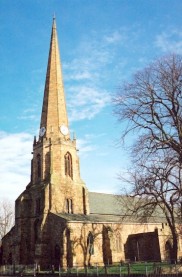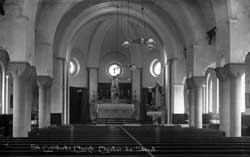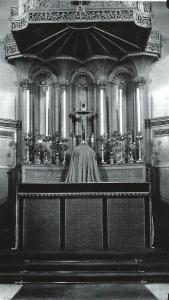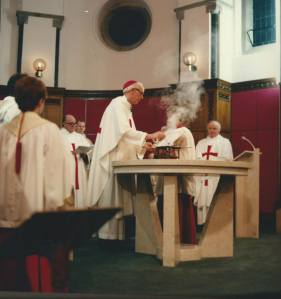The monks of Lindisfarne were forced to flee by Viking invasions in the ninth century wandering around the region bearing the incorrupt body of St Cuthbert for some eight years before settling at the former Roman fort of Concangis, now Chester-le-Street.Here Bishop Eardulf established his episcopal see and built a wooden church housing a shrine to St Cuthbert.
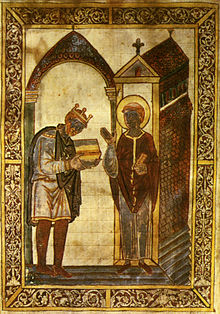
Æthelstan King of the English presents a copy of the Gospels and other gifts to the Shrine of St. Cuthbert at Chester-le-Street.
The shrine grew in importance and was visited by Alfred the Great’s son and successor Edward the Elder, as he sought to gain control of Northumbria from the Danes and by his grandsons Æthelstan, the first “King of the English” gave the shrine lands, plate books and vestments: “In the name of the Lord Jesus Christ, I, Athelstane, King, give to St. Cuthbert this copy of the Evangelists, two chasubles, one alb, one stole with a maniple, one girdle, three altar cloths, one chalice of silver, two patens, the one made of gold and cloths, other of Greek workmanship, one censer of silver, one cross ingeniously made of gold and ivory, one royal crown woven of gold, two tablets made of gold and silver, one missal, two copies of the Gospels ornamented with silver and gold, a Life of St. Cuthbert written in verse and prose, seven robes, three curtains, three pieces of tapestry, two cups of silver with covers, three large bells, two horns fabricated of gold and silver, two banners, one lance, and two bracelets of gold” as well as extensive estates, his victory at Brunanburgh in 937 brought further patronage. His successor and brother Edmund gave yet more land and estates making the bishop on of the most powerful figures in the North. Around 970 that Aldred “the Glossator” the provost of the Chester-le-Street community wrote an interlinear Old English translation into the Lindisfarne Gospels, this is now the oldest extant translation of the Gospels into English.
In 995 Bishop Aldhun was forced to flee from another Danish invasion, and the saint’s body made its way to Durham, via Ripon, leaving Chester-le-Street all but abandoned. In 1054 Æthelric, Bishop of Durham, built a new stone church on the site of the ninth century wooden one dedicated to Our Lady and St. Cuthbert, according to one legend in the process of tearing down the wooden structure the bishop found a huge hoard of gold, possibly Roman in origin, and promptly resigned his see and retired to the monastery of Peterborough in order to enjoy spending it.
A peace treaty between Stephen I of England and David I of Scotland was negotiated by the archbishops of York and Canterbury and the bishops of Glasgow and St. Andrews here in 1139 effectively sealing Scots control of North-Eastern England.
In 1286 the church in Chester-le-Street became a collegiate church with a dean, seven canons, five chaplains and three deacons, serving a parish which stretched from Gateshead to Durham and Houghton-le-Spring to Lanchester. From around 1383 the church also housed a series of six anchorites in what is now known as the Anker House which was equipped with a squint window so that the inhabitant could still take part in Mass. A massive spire was added in 1409 along with a set of three bells presented by Lord Lumley, Robert Ashburn, the dean of Chester-le-Street and “Cardinal” Thomas Langley, the bishop of Durham. Ashburn’s bell survives to this day, alongside eight newer replacements and is rung before services it is inscribed in Latin: “Master Robert Aschburn, Dean of Chester made me: This bell given is thus named Cuthbert” During the Reformation, the collegiate church, along with other religious houses, was dissolved and almost all the endowments seized by the crown leaving St. Mary’s and St. Cuthbert’s Church to become the Anglican parish church of Chester-le-Street, though it is perhaps worth noting that at the ascension of Queen Mary in 1553 the parish of Chester-le-Street was probably the first place to restore the Latin Mass well before official orders came out to do so.
Despite the Reformation Catholicism survived a long time in the North. Evidence of this locally can be found in the large number of men from Chester-le-Street and Lumley executed in the wake of the 1568 Rising of the Northern Earls which had seen Mass restored in Durham Cathedral and parishes throughout the area. Harsh repression followed with over 700 executed in towns and villages throughout the area. Elizabeth’s government enacted stiff penalties for recusancy and brutal laws against those training as priests in seminaries abroad or those sheltering them. Fr. Joseph Lambton of the famous local family was executed on Newcastle Town Moor under these statutes on 24th July 1592, aged just 24. He was beatified by Pope St. John Paul II in 1987.
In spite of the penal laws Catholicism hung on, if barely in the area, with priests constantly being hunted and the laity hit by ever increasing fines and sequestration of their estates. Fr. Richard Holtby S.J managed despite many narrow escapes to serve on the English mission for over 50 years, mainly around Durham. One of his bases was Harbour House Farm near Chester-le-Street owned by the Forcer family. Two members of that family became Jesuits while Bld. Ralph Corby S.J is also known to have said Mass at Harbour House. After his arrival in 1632, he ministered in the area for about 12 years before being captured, taken to London for trial he was hung, drawn and quartered on 7th September, 1644 at Tyburn. He was beatified by Pope Pius XI in 1929. The Hodgeson and Wray families of Beamish Manor also provided a refuge for priests caring for the area including the secular priest Fr. William Ogle who by 1649 had become archdeacon of the Northern counties and a member of the nation-wide chapter.
The number of surviving Catholics in Chester-le-Street is difficult to estimate, but in 1624 117 Catholic families, about half the town’s population were listed as recusants. Despite persecution members of several Catholic families served on the Royalist side during the Civil War.
Amongst the 20,000 Northern Catholics confirmed in 1687 by Bishop John Layburn, the new Vicar Apostolic, were a few from Chester-le-Street. In 1696 William Tempest, donated £300 to the Benedictines for the benefit of Catholics living in the area of Lumley Castle, where he had been steward. The Lumleys themselves were Catholic until the reign of James II when Richard Lord Lumley, defected, which caused some disruption to the mission.
It is unclear exactly when the Benedictines arrived however Fr. Bertram Edward Bulmer O.S.B spent thirty years from around 1715 in the area offering Mass in various houses, possibly including that of Tempest’s widow, before a chapel was established in Chester-le-Street, before that it is possible a priest came from Lintz Hall. Dom. Bulmer often disguising himself as a pedlar, as did Fr. Placid Rigby O.S.B his immediate successor. By 1723 the fines levied against Catholics in Chester-le-Street’s ward had risen to an annual £3263 18s and 8½d, a sum far beyond them (though they managed £704 14s). In 1732 there were thirty Catholic families in Chester-le-Street according to the episcopal returns
In 1746, the focus of the Benedictine mission was moved to Birtley, then a quiet village, by Father Anthony Leander Raffa, possibly in an attempt to hide from Anti-Jacobite rioting in the wake of Bonny Prince Charlie’s failed invasion; 14 Chester-le-street sympathisers had been named by the authorities as far back as 1744 and put under watch. In 1751 one of Fr. Raffa’s former pupils Ralph Brandling, of a rich mine-owning family left the mission £500 in return for 20 Masses per year, 2 per month at Felling Hall. Despite Fr. Raffa’s best efforts this led to disputes between the family and the Benedictines which were not resolved for over 20 years. According to the 1767 House of Lords return there were at least 172 Catholics including Fr. Robert Daniel OSB within Chester-le-Street parish, though the focus remained at Birtley, by the 1780’s they were mostly connected to coal-mining.The 1791 Catholic Relief Act allowed Catholics to build their own chapels provided they were simple, unadorned and in a secluded position. Birtley’s chapel dedicated to St. Joseph was registered on 29 October 1791, although it is said to have been built some years earlier
Debate continued within the Benedictine province once things settled down as to when the mission would return back to town: nearly a hundred years later in 1837 Fr. William Riddel O.S.B weighed up the pros and cons of such a move to the Bishop lamenting that the Catholics in Chester-le-Street itself were slothful and negligent,as things turned out the Benedictines stayed in Birtley.
The situation changed dramatically with the arrival of Irish immigrants drawn by the opening of many new mines throughout County Durham from the end of the 18th Century onwards, increasing further after the potato famine of 1845. Chester-le-Street itself saw trouble when on 1st January 1812 the then Prince-bishop of Durham sent in troops to break-up a miners strike which had lasted all winter.
In 1829 the Catholic Relief Act was passed by parliament repealing almost all the former penal laws dating back to the Reformation. Pope Bld. Pius IX restored the hierarchy in 1850, with a new diocese of Hexham (the “and Newcastle” was added in 1861) under Bishop William Hogarth but it nearly 30 years before Chester-le-Street became an independent Catholic parish once more, in the meanwhile Fr. (Sir) John Bede Swale OSB, and Fr. Joseph Sheridan, O.S.B. continued to visit from Birtley sometimes saying Mass in the Mechanics Institute on Newcastle Road.
In 1878 Fr. Patrick Thomas Matthews, possibly acting without due authority, built a presbytery in Lumley Terrace with a room was fitted up as a chapel, Confessions meanwhile were heard under the stairs. In 1881 Chester-le-Street formally became a separate mission under Fr.Henry Bluden, an annuity of £50 (then reckoned to be the bare minimum a mission needed) having been promised by a secret benefactor. Mass was also celebrated in the house of some parishioners named McGurk.

Pilgrimage to Holy Island to celebrate the 12th centenary of the death of St. Cuthbert. 12th Aug. 1887 around 10,000 people attended.
The twelfth centenary of the death of St Cuthbert fell six years later and was an occasion of special rejoicing throughout the diocese including pilgrimages to Holy Island and to Chester-le-Street. An appeal backed by Bishop Berwick, Provost Consitt (both of whom were to die shortly afterwards) and the Vicar Capitular Canon Wilkinson, sought to build a votive church in the saint’s honour, Chester-le-Street being chosen as the site and Pope Leo XIII granting an indulgence to those who contributed. Despite supposedly being the crowning goal of the anniversary, this appeal succeeded in raising only £300, so the then resident priest Rev. Dr. John Prior started to build a more modest brick school-chapel further along Lumley Terrace, designed by local architect Fred Pickering. Fr. Prior helped lay the foundation stone with now Auxiliary Bishop Wilkinson on 4th August 1888 just before being transferred to Rome. The new school chapel was opened in September 1888 by Fr. Michael Greene with a High Mass celebrated by Bishop Wilkinson. The school-chapel cost about £600 and served around 450 Catholics drawn from Pelton Fell, Chester Moor, Lumley and Waldridge as well as from the town itself, it could seat about 200. The school could accommodate 90 boys and girls but despite the best efforts of successive priests attendance was normally lower.Today this building houses the Catholic Social Club and Church Hall. Fr. Greene was in turn transferred in June 1889 to South Shields, with Fr. Edmund Barnet taking over. The Northern Catholic Calendar noting that there was “an excellent Catholic spirit amongst the little flock but as the parishioners are mostly of the labouring classes and there is now no endowment, the present income is hardly sufficient for parochial requirements.” Fr. Prior noted in a later letter that in his time here most of the congregation had in fact been drawn from the Union Workhouse which had opened in 1837 and occupied the site of the current hospital.
Efforts to build a proper church continued apace under Fr. Barnet’s successors with articles regularly appearing in the Tablet to raise national awareness e.g. from 4th Aug. 1894:
“With the approbation and blessing of the Lord Bishop of the diocese, and with the express sanction of his Holiness the Pope, who blesses all present and future benefactors, an effort is now being made to restore the ancient shrine of St. Cuthbert in this ancient city. A suitable site could be secured now if we had the necessary money. The new shrine will take the form of a votive church in honour of the great St. Cuthbert. It is hoped that every Catholic in England will contribute his mite in honour of the great Apostle of the North of England. Converts especially are asked to contribute as an act of thanksgiving for the great gift of faith. Collecting cards for the new shrine can be obtained on application to Your obedient servant, H. IGNATIUS BEALE. St. Cuthbert’s, Chester-le-street, co. Durham.”
Parish life continued in the school chapel with pews and desks having to be rearranged for Mass and social events, which was perhaps too active as Fr. Holmes noted for the bishop’s visitation in 1901 that “drunkenness (is) the curse of the place”
Work a proper church on building was finally started in 1902 with land bought from the Earl of Durham, a member of the Lambton family. Built in the Romanesque style to reflect the period in which St. Cuthbert’s body was here, the church is of stone with a slate roof, as is the presbytery which was built at the same time. The church opened in 1910 under Rev. Patrick Joseph Kearney and cost about £6000., a lot of the money having been borrowed from the diocese and Ushaw College. The high altar, altar stone, tabernacle and sanctuary lamp came from St Cuthbert’s in Durham, but of these possibly only the tabernacle survives here today. Originally the church was arranged without a centre aisle making funerals and weddings quite tricky before the post Vatican II reordering.

St. Cuthbert’s shortly after its opening, note that Ropery Lane is unpaved and the lack of surrounding houses.
Fr. Kearney was also not to enjoy the fruit of his labours for long being transferred to Whitley Bay in 1912, fortunately under the next two Parish Priests Frs. McKiernan and Johnson the parish was to experience 50 years of stability and almost constant growth.
A new school was built and opened on 24th August 1926, some parishioners buying bricks inscribed with their names or those of loved ones, each costing the then not inconsiderable sum of £1. Pupils of both sexes were admitted from age 5-14, with those who passed the 11+ exam able to transfer to either Oak Lea in Sunderland or St. Cuthbert’s in Newcastle; moving to Chester-le-Street Grammar being severely frowned upon. Eventually more classrooms and playing fields would be added and as the educational system changed and boundaries were redrawn pupils moved on to St. Bede’s in Lanchester, then to St. Robert’s in Washington, for which the parish helped raise funds and now mainly to St. Leonard’s in Durham.
The church itself was almost constantly being renovated and improved, with Fr. Johnson particularly organising vigorous fundraising efforts to buy a new altar, pulpit, vestments, and a huge pipe organ from a closing Congregational Chapel in Newcastle, many other items being donated by members of the parish and dedicated in memory of loved ones. Numbers grew as did the economic prosperity of the community, as can be seen in the growing number of parish pilgrimages abroad and the eventual need once more to have a resident curate. Another sign of the parish’s vitality was the steady flow of young men from the parish ordained to the priesthood, often returning to St. Cuthbert’s to offer their first Mass or Benediction. Fr. Hugh Lavery was actually ordained in the church on 14th Feb. 1943, before offering his first Mass the following day, served by a young Gerard Bradley.
The social life of the parish also flourished with frequent dances, whist drives, garden parties and fetes, all of which were revived after the restrictions of WWII and the requisitioning of the hall, with both men women and children taking part in organising and running events through various guilds, confraternities and committees in the church hall, school, the Empire Ballrooms and elsewhere.
After so many years of stability the 1960’s were very tumultuous for the parish, partly due to the calling of Vatican II but more pressingly perhaps by the sudden death of Fr. Johnson in 1962, rapidly followed by those of his immediate successors Fr. Leo Sharratt in 1963 and Fr. James Duggan in 1966. Nevertheless their successor Fr. James Scott reported that he found the parish thriving and dynamic, by 1967 Sunday Mass attendance was over 1,200.
In 1969 Chester-le-Street gained its first bishop in nearly a thousand years when the new auxiliary bishop of the diocese Hugh Lindsey was assigned “Cuncacestre” as his titular see, much to his initial confusion as he had no idea where his new see was! Bishop Lindsey became the diocesan ordinary five years later and was to be largely responsible for the implementation of Vatican II’s programme of “Aggiornamento” and liturgical reform in the diocese. “Cuncacestre” continues to be a Titular See having been inherited by Owen Swindlehirst, auxiliary to Bishops Lindsey and Griffiths from 1977-95, Alan Hopes, auxiliary bishop of Westerminter 2003-13 when he was appointed to East Anglia and most recently by Robert Byrne Cong. Orat., auxiliary of Birmingham from May 2014.
“Aggiornamento” and reform also came to the parish with a forward facing altar, Mass in English and new initiatives such as house Masses, family groups, lay readers and eucharistic ministers and many others being introduced gradually under Fr. Scott and his successors.
The parish was touched by tragedy again in 1974 when much loved curate Fr. Austen McElhatton died aged only 38. 40 years later he is still remembered fondly and regarded as a saint by many in the parish.
The parish’s centenary was celebrated in 1981 with a Mass celebrated by Bishop Swindlehirst and a party in the church hall.
As might be noted from the centenary pictures aside from the forward altar installed in 1968 the church remained largely as it had been under Fr. Johnston. This was to change soon after with the arrival of Fr. Michael McFadden who, acting under a mandate from Bishop Lindsey, re-ordered the church. The high altar, altar rails and pulpit were removed the sanctuary was extended outwards with a flight of semicircular steps projecting into the nave which now also had a central aisle as the pews had been cut down, the whole church was now carpeted. The sanctuary now features a large polished marble altar with circular mensa, accompanied by a matching ambo and font which is now placed just off the sanctuary at the front of the church. The tabernacle was removed from the altar and placed in an alcove to the left, though it has recently been returned to a central position on a new wooden pedestal. Far more radical plans had in fact been drawn up which would have seen a large new octagonal chapel and sacristy built connected to the church by knocking through the former baptistry apse. In retrospect it is perhaps fortunate that funds were not available to complete this work which would have drastically altered our site. Bishop Swindlehirst returned to the parish to re-dedicate the church and to consecrate the new altar in a special Mass held on 29th Nov. 1984.
In recent times the parish became a centre for the charismatic renewal under Fr. Sean Conaty and also for youth ministry largely inspired by Fr. Dermott Donnelly who was to go on to be diocesan and now national director of Youth Ministry.
Prayer, liturgy, community outreach, lay involvement and social events continue to flourish, the later helped greatly by the building of a new on-site “Coffee shop” in 2006 replacing an earlier temporary building which had burnt down.
We pray that in spite of difficulties and uncertainties felt across the diocese and wider Church St. Cuthbert’s will continue to flourish into the future.
